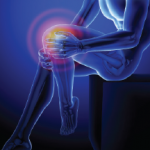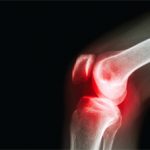Thirty years ago, knee osteoarthritis (OA), like gray hair and bags under the eyes, was thought to be an inevitable and largely untreatable consequence of getting old. But in the decades since, medical science has refuted the idea of OA as simply a “wear-and-tear” disease. New research shows that metabolic changes in the cartilage that are hallmarks of knee OA often occur after knee injury in young and middle-aged adults, too—and are often undetected for years.
Although OA is more prevalent with increasing age (11–15% of American adults 65 and older have OA in one or both knees), it’s found in a significant portion of middle-aged patients, too. “By their 30s and 40s, about 5% of the population has radiographic signs of OA, and we know disease might start 10 years prior to that,” explains Ewa Roos, PT, PhD, professor in the Institute of Sports Science and Clinical Biomechanics of the University of Southern Denmark. She spoke in a session at the ACR/ARHP Annual Scientific Meeting in November 2007.
There are a couple of obvious differences between the two populations of knee OA patients, Dr. Roos adds. For one, most elderly OA patients are women; in the younger groups, most OA patients are men. “And there are always differences in bone structure, cartilage, and muscles when you’re 35 and when you’re 75,” she says.
“Osteoarthritis is now listed on the World Health Organization’s top 10 list of global disease burden, with the knee being one of the most frequently affected joints,” says clinical epidemiologist Martin Englund, MD, PhD, a research associate at the Boston University School of Medicine and another speaker at the session. In the future, as the growing numbers of middle-aged people with undetected OA get older, the disease is only going to become a bigger public health problem.
Drs. Englund and Roos discussed how to diagnose and prevent OA in these younger age groups at a session called “Young Patients With Old Knees.”
Knee Pain in OA
The biggest problem in diagnosing OA in middle-aged patients is that those with OA symptoms—like pain, swelling, or stiffness—don’t always show signs of the disease on X-rays or even MRIs. The reverse is also true: Those with radiological evidence of the disease—such as joint narrowing due to cartilage loss and osteophytes—are not always symptomatic. Even more frustrating, “progression from high-risk groups into either of these categories is not well understood,” says Dr. Englund.
Researchers do know common risk factors for OA, though. The disease is initiated and propagated because of both endogenous risk factors, such as age and genetics, and environmental risk factors, such as being overweight or sustaining a knee injury. Dr. Englund’s presentation focused on the two most common environmental risk factors that lead to old knees on young adults: knee injury from damage to the anterior cruciate ligament (ACL) and knee injury from damage to the meniscus. He presented results of research published in Arthritis & Rheumatism that shed new light on the pain associated with meniscal tears.1
Tears to the menisci are commonly found on MRI images and are related to aging, obesity, and athletic injuries. “If I were to extrapolate data, there are today about 5 million U.S. adults age 50 and above that have a meniscal tear,” says Dr. Englund. Patients with these tears sometimes feel pain. But before Dr. Englund’s research, nobody knew if the tears actually caused the pain, or if it came from a different source, such as OA.
In this prospective Multicenter Osteoarthritis Study, Dr. Englund and his colleagues recruited 3,026 individuals aged 50 to 79 who had a high risk of developing osteoarthritis of the knee. One hundred ten case knees were chosen randomly from those patients who did develop symptoms in 15 months; 220 control knees were chosen from the patients who did not develop symptoms. An independent panel of radiologists compared the MRI images of both groups at baseline and at 15 months to see if pain symptoms correlated with damage to the meniscus.
At baseline, 38% of case knees and 29% of control knees had meniscal damage, with a higher frequency among women. The researchers also found that the degree of meniscal damage did correlate slightly with the development of knee pain and stiffness. However, after a thorough statistical analysis, the researchers found no independent association between the degree of meniscal tearing and the development of pain symptoms.
Dr. Englund theorizes that because OA almost always accompanied meniscal tears, it’s conceivable that the OA causes the pain symptoms.
Advantages of Exercise
In her presentation, Dr. Roos discussed the role of exercise in the prevention of knee OA in middle-aged patients. “We have known for quite some years now that exercise is actually evidence-based medicine for patients with knee OA to reduce pain and improve physical function,” she says.
In another study from Arthritis & Rheumatism, Dr. Roos and Leif Dahlberg, MD, of Lund University Hospital in Lund, Sweden, showed how moderate exercise can strengthen joint cartilage in middle-aged patients at risk of OA.2 They studied 45 patients aged 35–50 who had undergone meniscus repair within the past three to five years. Half of these subjects were used as controls; the other half went into a supervised exercise program three times a week. After four months, MRIs of all subjects were compared for cartilage glycosaminoglycan (GAG) content, a good measure of strength and elasticity.
The exercise group not only had a better GAG content, but those subjects reported gains in physical activity and functional performance. “The changes imply that human cartilage responds to physiologic loading in a way similar to that exhibited by muscle and bone,” Dr. Dahlberg notes in the article. Moreover, improvements in symptoms of the patients with OA who exercised “may occur in parallel or even be caused by improved cartilage properties.”
Dr. Roos and colleagues published a study in BMC Musculoskeletal Disorders showing the effect of exercise on knee stiffness after an ACL injury (which, as noted above, is often accompanied by OA).3 She studied 12 men who had been soccer players and had sustained an ACL injury 16 years earlier. Twelve weeks of knee-specific neuromuscular training—including balance, rubber band resistance, hopping, and lifting exercises—reduced knee stiffness in these subjects. Moreover, they reported better function in recreational sports.
Practicing rheumatologists should keep in mind, however, that knee OA patients may resist exercise recommendations. In early 2006, Dr. Roos interviewed 16 middle-aged patients to find out their conceptions of exercise as an effective form of treatment for knee OA. She found that although patients with knee OA and pain are aware of the health benefits of exercise, many have doubts and concerns. One of the most common questions patients have asked her over the years, Dr. Roos mentioned in her presentation, is, “Will I wear the joint down if I exercise?” If exercising properly, the answer is definitively no, she says—and it’s up to the rheumatology healthcare team to get that message across.
Virginia Hughes is a medical writer based in New York City.
References
- Englund M, Niu J, Guermazi A, et al. Effect of meniscal damage on the development of frequent knee pain, aching, or stiffness. Arthritis Rheum. 2007; 56:4048–4054.
- Roos EM, Dahlberg L. Positive effects of moderate exercise on glycosaminoglycan content in knee cartilage: A four-month, randomized, controlled trial in patients at risk of osteoarthritis. Arthritis Rheum. 2005; 52:3507–3514.
- von Porat A, Henriksson M, Holmström E, Roos EM. Knee kinematics and kinetics in former soccer players with a 16-year-old ACL injury—the effects of twelve weeks of knee-specific training. BMC Musculoskelet Disord. 2007;8:35.


